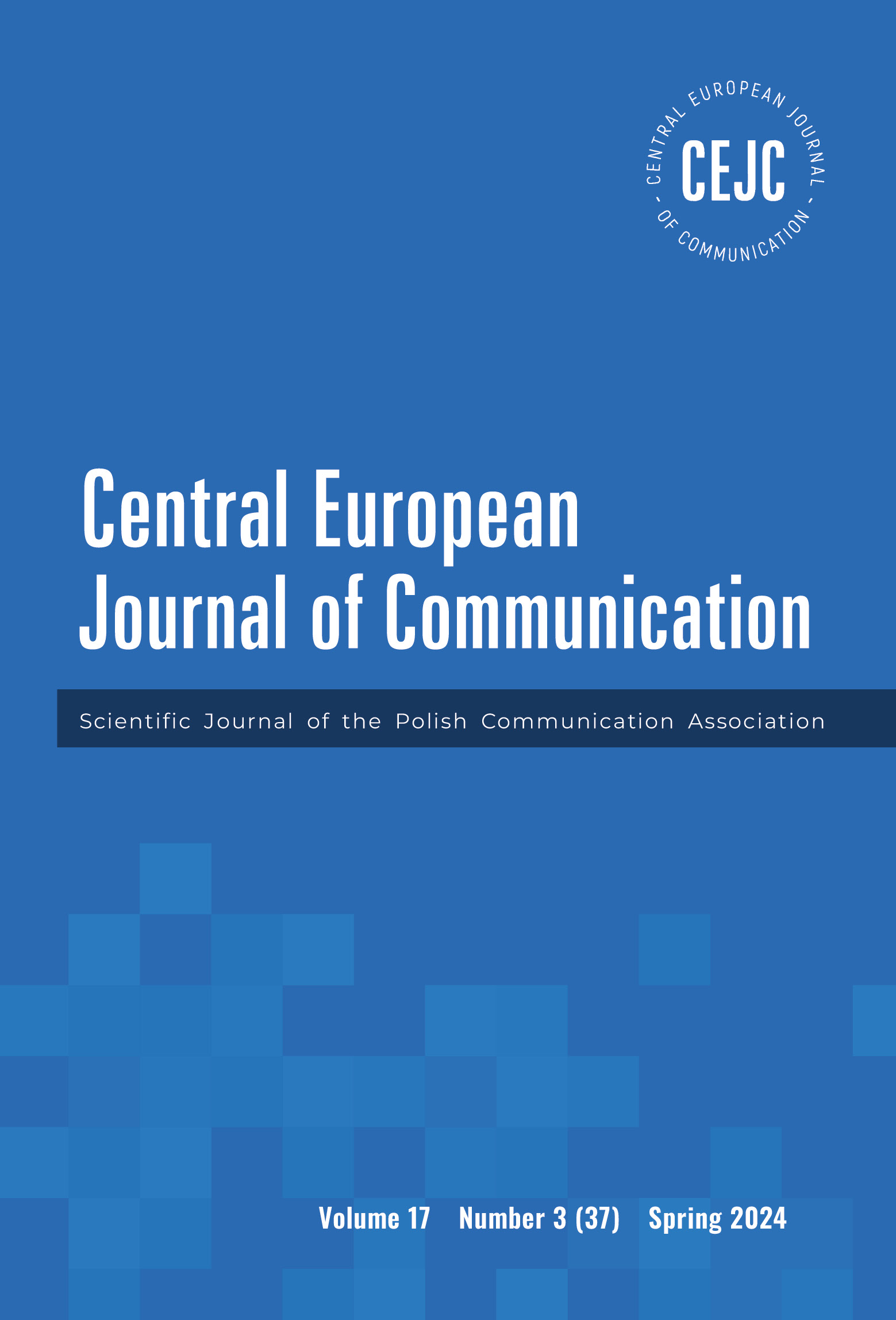Less is more. Study on slow journalism outlets’ authors
DOI:
https://doi.org/10.51480/1899-5101.17.3(37).640Keywords:
slow journalism, alternative journalism, journalism practice, storytelling, time pressureAbstract
The concept of slow journalism has evolved from the dissatifaction with speed-driven journalism. Discussion about this form of journalism has revolved around what it is or should be, what its goals might be, what principles it should follow, and how. Although authors play an essential role in achieving its goals, there is a lack of empirical research about their motivation and practices. I interviewed 22 authors and conducted four observations in two slow journalism outlets in Estonia. The results show that the authors are motivated by contributing to society, their autonomy, and self-fulfillment, which they were often not afforded in other outlets. However, some journalists had difficulties switching from one set of principles and values to other and experienced problems with time management, storytelling, and self-motivation. Non-journalists may bring some advantages in following slow journalism principles and working with sources.
References
Allan, S. (2022). The Routledge Companion to News and Journalism (2nd ed.). Routledge. DOI: 10.4324/9781003174790
Andersen, K. (2022). Realizing Good Intentions? A Field Experiment of Slow News Consumption and News Fatigue. Journalism Practice, 16(5), 848–863. DOI: 10.1080/17512786.2020.1818609
Ball, B. (2016). Multimedia, Slow Journalism as Process, and The Possibility of Proper Time. Digital Journalism, 4(4), 432–444. DOI: 10.1080/21670811.2015.1114895
Barranquero Carretero, A., & Jaurrieta Bariain, G. (2016). Slow Journalism in Spain: New magazine startups and the paradigmatic case of Jot Down. Journalism Practice, 10(4), 521–538. DOI: 10.1080/17512786.2015.1124729
Berkey‑Gerard, M. (2009). Tracking the “Slow Journalism” Movement. Markberkeygerard.Com. https://web.archive.org/web/20120911165001/http://markberkeygerard.com/2009/07/tracking-the-%E2%80%9Cslow-journalism%E2%80%9D-movement/
Braun, V., & Clarke, V. (2006). Using thematic analysis in psychology. Qualitative Research in Psychology, 3(2), 77–101. DOI: 10.1191/1478088706qp063oa
Cheng, L. (2021). The Practice and Presentation of Slow Journalism: A Case Study of Kinfolk Magazine. Journalism Practice, 0(0), 1–18. DOI: 10.1080/17512786.2021.1969987
Craig, G. (2016). Reclaiming Slowness in Journalism: Critique, complexity and difference. Journalism Practice, 10(4), 461–475. DOI: 10.1080/17512786.2015.1100521
Deuze, M., & Prenger, M. (Eds.). (2019). Making Media: Production, Practices, and Professions. Amsterdam University Press. DOI: 10.2307/j.ctvcj305r
Drok, N., & Hermans, L. (2016). Is there a future for slow journalism?: The perspective of younger users. Journalism Practice, 10(4), 539–554. DOI: 10.1080/17512786.2015.1102604
Eriksen, T. H. (2001). Tyranny of the moment: Fast and slow time in the information age. Pluto Press.
Fulton, J., & Scott, P. (2022). Time Well Spent: ABC Journalists Reflect on Slow Journalism and the Remote Communities Project. Journalism Practice, 16(8), 1597–1613. DOI: 10.1080/17512786.2021.1874485
Gess, H. (2012). Climate change and the possibility of ‘slow journalism.’ Ecquid Novi: African Journalism Studies, 33(1), 54–65. DOI: 10.1080/02560054.2011.636828
Gibbs, C., & Warhover, T. (2002). Getting the whole story: Reporting and writing the news. Guilford Press.
Given, L. M. (Ed.). (2008). The Sage encyclopedia of qualitative research methods. Sage Publications.
Greenberg, S. (2012). Slow Journalism in the Digital Fast Lane. In R. Keeble & J. Tulloch (Eds.), Global literary journalism: Exploring the journalistic imagination (pp. 381–393). Peter Lang. https://www.academia.edu/5199522/Slow_Journalism_in_the_Digital_fast_Lane
Greenberg, S. (2007). Slow Journalism. Why doesn’t Britain have a culture of serious non-fiction journalism like the US? Prospect. https://www.prospectmagazine.co.uk/opinions/57661/slow-journalism
Hallin, D. C., & Mancini, P. (2004). Comparing Media Systems: Three Models of Media and Politics (1st ed.). Cambridge University Press. DOI: 10.1017/CBO9780511790867
Harrington, W. (Ed.). (1997). Intimate journalism: The art and craft of reporting everyday life. Sage Publications.
Hermann, A. K. (2016). The Temporal Tipping Point: Regimentation, representation and reorientation in ethnographic journalism. Journalism Practice, 10(4), 492–506. DOI: 10.1080/17512786.2015.1102605
Kõuts‑Klemm, R., Harro‑Loit, H., Ibrus, I., Ivask, S., Juurik, M., Jõesaar, A., Järvekülg, M., Kauber, S., Koorberg, V., Lassur, S., Loit, U., & Tafel‑Viia, K. (2019). Study of mediapolitics and developments [Meediapoliitika olukorra ja arengusuundade uuring]. University of Tartu, Institute of Social Studies. https://www.digar.ee/arhiiv/nlib-digar:399372
Kvale, S., & Brinkmann, S. (2015). InterViews: Learning the craft of qualitative research interviewing (Third edition). Sage Publications.
Le Masurier, M. (2015). What is Slow Journalism? Journalism Practice, 9(2), 138–152. DOI: 10.1080/17512786.2014.916471
Mendes, I., & Marinho, S. (2022). Slow Journalism: A Systematic Literature Review. Journalism Practice, 1–31. DOI: 10.1080/17512786.2022.2075783
Mey, G., & Mruck, K. (Eds.). (2010). Handbuch qualitative Forschung in der Psychologie (1. Auflage). VS Verl. für Sozialwiss.
Neveu, E. (2016). On not going too fast with slow journalism. Journalism Practice, 10(4), 448–460. DOI: 10.1080/17512786.2015.1114897
Örnebring, H., & Schmitz Weiss, A. (2021). Journalism and the Politics of Mobility. Journalism Studies, 22(14), 1894–1910. DOI: 10.1080/1461670X.2021.1971108
Palau‑Sampio, D. (2019). Reframing Central American Migration From Narrative Journalism. Journal of Communication Inquiry, 43(1), 93–114. DOI: 10.1177/0196859918806676
Rauch, J. (2018). Slow media: Why “slow” is satisfying, sustainable and smart. Oxford University Press.
Reinardy, S. (2010). Need for Speed onto Internet Clashes with Journalistic Values. Newspaper Research Journal, 31(1), 69–83. DOI: 10.1177/073953291003100106
Reinardy, S. (2013). Depleted Resources Causing Burnout for Layoff Survivors. Newspaper Research Journal, 34(3), 6–21. DOI: 10.1177/073953291303400302
Siebert, S.T., Peterson, T., Schramm, W. (1984). Four Theories of the Press: The Authoritarian, Libertarian, Social Responsibility, and Soviet Communist Concepts of What the Press Should Be and Do. University of Illinois Press. DOI: 10.5406/j.ctv1nhr0v
Siil, V., Kõuts‑Klemm, R. (2023). Survival of the Slowest. A Case Study of Two Slow Journalism Outlets in Estonia. Mediální studia, 17(1), 7–26.
Sikk, T. (2023). How are the readers of Edasi and Levila perceiveing their goals [Kuidas tajuvad Edasi ja Levila lugejad nende väljaannete eesmärke]. University of Tartu, Institute of Social Studies. https://dspace.ut.ee/items/87419e21-53d8-46a5-b84a-7db97010202c
Thomas, H. M. (2016). Lessening the Construction of Otherness: A slow ethics of journalism. Journalism Practice, 10(4), 476–491. DOI: 10.1080/17512786.2015.1120164
Vihalemm, P. and Kõuts‑Klemm, R. (2017) Meediakasutuse muutumine: internetiajastu saabumine [Change in media usage: arrival of the internet age]. In P. Vihalemm, M. Lauristin, V. Kalmus ja T. Vihalemm (Eds.) Eesti ühiskond kiirenevas ajas: uuringu Mina. Maailm. Meedia 2002–2014 tulemused. Tartu: Tartu Ülikooli kirjastus, 251–278
Vihalemm, T. (2022). Media, miners and the injustices of sustainable transition in North‑East Estonia. The Extractive Industries and Society, 11, 101129. DOI: 10.1016/j.exis.2022.101129
Downloads
Published
How to Cite
Issue
Section
License
Copyright (c) 2025 Polish Communication Association

This work is licensed under a Creative Commons Attribution-ShareAlike 4.0 International License.


